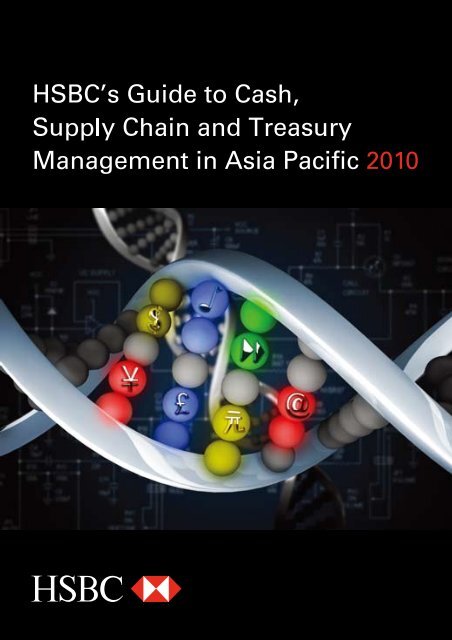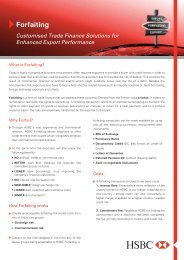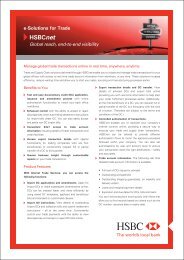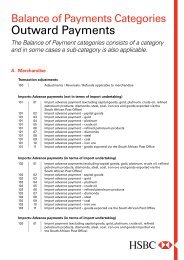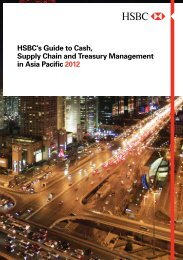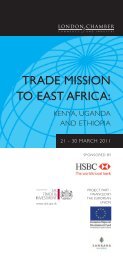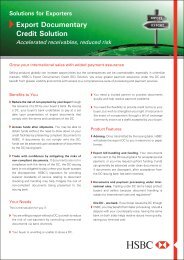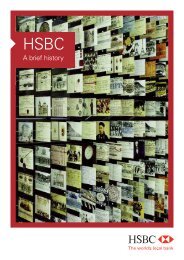HSBC's Guide to Cash, Supply Chain and Treasury - HSBC Africa
HSBC's Guide to Cash, Supply Chain and Treasury - HSBC Africa
HSBC's Guide to Cash, Supply Chain and Treasury - HSBC Africa
You also want an ePaper? Increase the reach of your titles
YUMPU automatically turns print PDFs into web optimized ePapers that Google loves.
<strong>HSBC</strong>’s <strong>Guide</strong> <strong>to</strong> <strong>Cash</strong>, <strong>Supply</strong> <strong>Chain</strong> <strong>and</strong> <strong>Treasury</strong><br />
Management in Asia Pacific 2010<br />
Publisher:<br />
Managing Edi<strong>to</strong>r:<br />
Edi<strong>to</strong>rs:<br />
Advertising Sales:<br />
Design & Production Manager:<br />
Cover Design:<br />
Printer:<br />
David Tait<br />
S<strong>and</strong>ra Kong<br />
Terri Fitsell, Kerry Nelson<br />
Jo Allum<br />
Deborah Lee<br />
Grant Pang<br />
DG3 Asia Limited<br />
With thanks <strong>to</strong> Trudy Frection, Head of Market Development, <strong>and</strong> Katherine Mountain, Marketing Officer, Publications,<br />
Market Development, Global Payments <strong>and</strong> <strong>Cash</strong> Management, Asia Pacific, <strong>HSBC</strong>, Hong Kong.<br />
PUBLISHER’S NOTE<br />
The opinions expressed in this publication are not necessarily those of the publisher, The Hongkong <strong>and</strong> Shanghai Banking<br />
Corporation Limited (“<strong>HSBC</strong>”) or the institutions for which the contributing authors work. Although every care has been<br />
taken <strong>to</strong> ensure the accuracy of the information contained within the publication, the publisher, <strong>HSBC</strong>, authors <strong>and</strong><br />
their employers accept no responsibility for any inaccuracies, errors or omissions howsoever arising, whether through<br />
negligence or otherwise.<br />
This publication is sold on the underst<strong>and</strong>ing that the publisher, <strong>HSBC</strong>, authors <strong>and</strong> their employers are not responsible<br />
for the results of any actions, errors or omissions taken on the basis of information contained in this publication. This<br />
publication is not, <strong>and</strong> should not be, construed as financial or other professional advice or as an offer <strong>to</strong> sell or the<br />
solicitation of an offer <strong>to</strong> purchase or subscribe for any financial products or services by the publishers, <strong>HSBC</strong>, authors <strong>and</strong><br />
their employers. The publisher is not engaged in the rendering of accounting, financial or other professional services. The<br />
publisher, <strong>HSBC</strong>, authors <strong>and</strong> their employers expressly disclaim all <strong>and</strong> any liability <strong>to</strong> any person, whether a purchaser<br />
of this publication or not, in respect of any action or omission or the consequences of any action or omission by any such<br />
person in reliance, whether whole or partial, upon the whole or part of the contents of this publication. If financial or other<br />
advice is required, the services of a competent professional should be sought.<br />
Issued by <strong>HSBC</strong> Holdings Plc on behalf of the <strong>HSBC</strong> Group members which are regulated in jurisdictions where permitted,<br />
The Hongkong <strong>and</strong> Shanghai Banking Corporation Limited, incorporated in the Hong Kong Special Administrative Region<br />
with limited liability, The Hongkong <strong>and</strong> Shanghai Banking Corporation Limited – Johannesburg Branch (2006/033197/10), an<br />
Authorised Financial Services Provider, <strong>HSBC</strong> Bank Australia Limited ABN 48 006 434 162 AFSL 232595 in Australia for the<br />
information of its “wholesale” clients (within the meaning of the Corporations Act 2001) only, <strong>HSBC</strong> Bank (China) Company<br />
Limited in China <strong>and</strong> <strong>HSBC</strong> Bank Malaysia Berhad (Company No. 127776-V) in Malaysia. The products <strong>and</strong> services<br />
mentioned herein are only available in jurisdictions where the respective issuers are authorised <strong>to</strong> operate <strong>and</strong> the material<br />
is not intended for use by persons located in or resident in jurisdictions which restrict the distribution of this material.<br />
© Copyright. PPP Company Limited <strong>and</strong> The Hongkong <strong>and</strong> Shanghai Banking Corporation Limited. November 2009.<br />
ALL RIGHTS RESERVED. ISBN: 978-988-18303-9-5<br />
No part of this work may be reproduced in any form by any means, graphic, electronic or mechanical, including<br />
pho<strong>to</strong>copying, recording, taping or information s<strong>to</strong>rage <strong>and</strong> retrieval, without the prior written permission of the publisher<br />
<strong>and</strong> <strong>HSBC</strong>. Any unauthorised use of this publication will result in immediate legal proceedings.<br />
Compiled <strong>and</strong> published by:<br />
PPP Company Limited, 20/F Carfield Commercial Building, 75–77 Wyndham Street, Central, Hong Kong<br />
Tel: [852] 2973 6791 Fax: [852] 2869 4554 E-mail: inquiries@ppp.com.hk
<strong>Africa</strong>n Trade with China <strong>and</strong> India: From Strength <strong>to</strong> Strength<br />
<strong>Africa</strong>n Trade with China <strong>and</strong> India:<br />
From Strength <strong>to</strong> Strength<br />
Sohfern Boey, Head of Trade <strong>and</strong> <strong>Supply</strong> <strong>Chain</strong>, <strong>HSBC</strong>, China, Bhriguraj Singh, Head of Trade <strong>and</strong><br />
<strong>Supply</strong> <strong>Chain</strong>, <strong>HSBC</strong>, India, <strong>and</strong> Trini Antunes, Head of Trade <strong>and</strong> <strong>Supply</strong> <strong>Chain</strong>, <strong>HSBC</strong>, South <strong>Africa</strong><br />
Markets, Tax <strong>and</strong> Regula<strong>to</strong>ry Outlook<br />
• <strong>Africa</strong>n trade with China <strong>and</strong><br />
India has grown inexorably over<br />
the past five years.<br />
• There are tentative signs that<br />
the composition of this trade is<br />
starting <strong>to</strong> change, with some<br />
<strong>Africa</strong> countries beginning <strong>to</strong><br />
export manufactured valueadded<br />
goods <strong>to</strong> China.<br />
• However, the challenges faced<br />
by Chinese <strong>and</strong> Indian importers<br />
<strong>and</strong> exporters dealing with <strong>Africa</strong><br />
remain significant. These include<br />
unfamiliar business practices,<br />
wide fluctuations in foreign<br />
exchange rates <strong>and</strong> uncertainties<br />
regarding the credit status of<br />
trading counterparties.<br />
• Neither Chinese or Indian<br />
domestic banks nor <strong>Africa</strong>n<br />
banks are well placed <strong>to</strong> assist<br />
in dealing with these challenges;<br />
a suitable banking partner for<br />
these markets requires a mix<br />
of global product <strong>and</strong> solution<br />
sophistication, <strong>and</strong> local<br />
expertise.<br />
While China <strong>and</strong> India’s trade flows are still relatively<br />
modest when compared <strong>to</strong> those of Europe, both countries<br />
have in recent years seen a very marked increase in bilateral<br />
trade with sub-Saharan <strong>Africa</strong>. Total bilateral trade between<br />
China <strong>and</strong> <strong>Africa</strong> in 2008 was slightly in excess of USD65bn, up<br />
from about USD40bn in 2007 on a trajec<strong>to</strong>ry of steady growth.<br />
In the case of India, the figures are even more impressive, with<br />
bilateral <strong>Africa</strong> trade in 2007–08 at about USD24.5bn, up from<br />
USD5bn in 2003–04 – again on a steady growth trajec<strong>to</strong>ry.<br />
The relative importance of <strong>Africa</strong>n countries as trading<br />
partners has also been increasing. <strong>Africa</strong>’s share of India’s<br />
imports s<strong>to</strong>od at 3% in 2004 <strong>and</strong> after dipping slightly in<br />
2004–05 <strong>and</strong> 2005–06 has continued <strong>to</strong> increase, hitting 6.7%<br />
in 2008–09 (April–December). The picture for Indian exports <strong>to</strong><br />
<strong>Africa</strong> is similarly encouraging; starting at 3% in 2003–04 <strong>and</strong><br />
reaching 6.2% in 2008–09 (April–December) on steady growth.<br />
Future Prospects<br />
While recent falls in commodity prices <strong>and</strong> a relative reduction<br />
in China’s recent meteoric growth rate are likely <strong>to</strong> have a shortterm<br />
impact on Sino–<strong>Africa</strong>n trade, the longer-term prognosis is<br />
good. Initiatives such as the China–<strong>Africa</strong> Development Fund<br />
(CADF), which will eventually commit USD5bn over the next<br />
five years <strong>to</strong> assist Chinese firms in exp<strong>and</strong>ing their operations<br />
across the <strong>Africa</strong>n continent, give a clear indication of the longterm<br />
commitment China is making <strong>to</strong> <strong>Africa</strong>. 1 Furthermore, the<br />
establishment of initiatives such as CADF indicates the implementation of a far broader approach <strong>to</strong> trade<br />
with <strong>Africa</strong> than merely an exchange of commodities for money.<br />
A similarly positive long-term outlook applies <strong>to</strong> India’s trade relations with <strong>Africa</strong>. Despite India’s<br />
recent decline in overall exports, India–<strong>Africa</strong>n bilateral trade is projected <strong>to</strong> grow by a fac<strong>to</strong>r of nearly 10<br />
<strong>to</strong> reach USD150bn by 2012, according <strong>to</strong> the Associated Chambers of Commerce <strong>and</strong> Industry of India<br />
(ASSOCHAM). In a recent report on <strong>Africa</strong>, the association projected that <strong>Africa</strong> will continue <strong>to</strong> have<br />
greater business significance for India, which will continue <strong>to</strong> drive strong two-way trade growth. 2<br />
The general economic backdrop for many <strong>Africa</strong>n countries is also reasonable, albeit less optimistic than<br />
in recent years. The Organisation for Economic Cooperation <strong>and</strong> Development (OECD) recently published<br />
1. For more information, see web site www.cadfund.com.<br />
2. The ASSOCHAM <strong>Africa</strong> Manual 2008. See www.assocham.org.<br />
192 <strong>HSBC</strong>’s <strong>Guide</strong> <strong>to</strong> <strong>Cash</strong>, <strong>Supply</strong> <strong>Chain</strong> <strong>and</strong> <strong>Treasury</strong> Management in Asia Pacific 2010
<strong>Africa</strong>n Trade with China <strong>and</strong> India: From Strength <strong>to</strong> Strength<br />
its forecasts for key sub-Saharan economies. 3 The OECD expects South <strong>Africa</strong>n growth <strong>to</strong> fall <strong>to</strong> 1.1% in<br />
2009, well below the 5% seen in the past three years, but it also expects GDP <strong>to</strong> recover <strong>to</strong> 3.5% in 2010. The<br />
prediction for Nigeria in 2009 is a more modest decline <strong>to</strong> 4% from 6.1% in 2008, while Kenya is expected<br />
<strong>to</strong> post growth of 5% <strong>and</strong> 4.3% in 2009 <strong>and</strong> 2010 respectively, bouncing back from the political violence that<br />
marred 2008. Apart from South <strong>Africa</strong>, the OECD expects Mauritius <strong>to</strong> post the largest decline in growth in<br />
2009 <strong>to</strong> 3% in comparison with 4.8% in 2008, with the key textile <strong>and</strong> <strong>to</strong>urism sec<strong>to</strong>rs negatively affected<br />
by recession in the US <strong>and</strong> Europe. However, while these <strong>Africa</strong>n states may see slower growth in 2009 than<br />
2008, it is noteworthy that they are still showing growth at all, in contrast with the declines seen in many<br />
developed economies such as the US <strong>and</strong> the UK.<br />
Composition<br />
The preceding two years have seen some interesting shifts in the pattern of trade between Asia <strong>and</strong> <strong>Africa</strong>. In<br />
the case of China, South <strong>Africa</strong>n exports are perhaps predictably <strong>to</strong>pped by minerals, with a 60% share of the<br />
<strong>to</strong>tal in 2007, rising <strong>to</strong> 61% in 2008. Interestingly, base metal <strong>and</strong> base metal product exports declined from<br />
27% <strong>to</strong> 21% over the same period. However, the most striking change (in percentage terms) has been in the<br />
increase in precious metals <strong>and</strong> products exports, which quintupled from 1% <strong>to</strong> 5% over the same period.<br />
Other significant exports include chemical products; textiles; plastics <strong>and</strong> rubbers; <strong>and</strong> paper <strong>and</strong> wood pulp.<br />
Significant declines were seen in various other commodities between 2007 <strong>and</strong> 2008 including foodstuffs,<br />
<strong>and</strong> machinery <strong>and</strong> electrical products, although in all cases these were from already relatively low levels.<br />
On the import side, machinery <strong>and</strong> electrical products represent comfortably the largest purchases by<br />
southern <strong>Africa</strong>n countries from China, rising from 43% of <strong>to</strong>tal imports in 2007 <strong>to</strong> 46% in 2008. Base metals<br />
<strong>and</strong> base metal product imports from China also rose from 8% <strong>to</strong> 9% over the same period. Other significant<br />
imports include textiles, chemical products, furniture <strong>and</strong> transportation.<br />
India’s five largest trade partners in <strong>Africa</strong> are (in order of importance) Nigeria, South <strong>Africa</strong>, Angola,<br />
Kenya <strong>and</strong> Mauritius. In the case of Nigeria, primary imports from India are engineering products such as<br />
machinery, moulds <strong>and</strong> engines, while major exports <strong>to</strong> India include mineral fuels, aluminium, lead, <strong>and</strong><br />
fruits <strong>and</strong> nuts. In the case of South <strong>Africa</strong>, major imports from India are vehicles, pharmaceutical products,<br />
machinery, <strong>and</strong> precious <strong>and</strong> semi-precious s<strong>to</strong>nes, while major exports <strong>to</strong> India include precious s<strong>to</strong>nes,<br />
mineral fuels <strong>and</strong> ores.<br />
Markets, Tax <strong>and</strong> Regula<strong>to</strong>ry Outlook<br />
Patterns <strong>and</strong> Trends<br />
To date, <strong>Africa</strong>’s exports <strong>to</strong> China <strong>and</strong> India have been largely driven by increasing dem<strong>and</strong> in those countries<br />
for primary commodities <strong>to</strong> supply their burgeoning industrial sec<strong>to</strong>rs. These primary commodities currently<br />
represent well over 80% of <strong>Africa</strong>’s exports <strong>to</strong> Asian countries, while a similar percentage of its imports are<br />
of manufactured goods.<br />
While this breakdown has proven relatively stable, there has been some movement. For example, China<br />
recently started importing certain <strong>Africa</strong>n manufactured value-added goods, including household consumer<br />
goods <strong>and</strong> processed food. A more pronounced shift has been in the balance of trade flows since the early<br />
1990s. While <strong>Africa</strong>’s imports from China <strong>and</strong> India have grown over this period, its exports have grown<br />
considerably faster, thus substantially reducing the overall trade deficit <strong>and</strong> freeing up further import capacity.<br />
Another emergent trend is China’s interest in growing its level of oil imports from <strong>Africa</strong>. While <strong>Africa</strong><br />
significantly lags the Middle East as a holder of proven oil reserves, analysts believe that it could harbour<br />
appreciable undiscovered reserves – a view that China evidently shares.<br />
India may not have so prominent a presence in <strong>Africa</strong> as China, but has made clear its commitment as<br />
it has <strong>to</strong> compete with China <strong>and</strong> other developed countries <strong>to</strong> secure oil <strong>and</strong> other commodities <strong>to</strong> support<br />
its growing economy. This desire <strong>to</strong> build closer relations with <strong>Africa</strong>n countries is apparent from various<br />
3. <strong>Africa</strong>n Economic Outlook 2009, published by the OECD in May 2009. See www.oecd.org.<br />
<strong>HSBC</strong>’s <strong>Guide</strong> <strong>to</strong> <strong>Cash</strong>, <strong>Supply</strong> <strong>Chain</strong> <strong>and</strong> <strong>Treasury</strong> Management in Asia Pacific 2010 193
<strong>Africa</strong>n Trade with China <strong>and</strong> India: From Strength <strong>to</strong> Strength<br />
Indian government announcements. For example, at the 2008 India–<strong>Africa</strong> Forum the Indian prime minister<br />
declared that India would increase its trade credits <strong>to</strong> <strong>Africa</strong> <strong>to</strong> USD5.4bn in 2008–09, as well as doubling the<br />
number of scholarships it offers <strong>Africa</strong>n students. 4<br />
Traditionally, Indian companies have focused on selling in<strong>to</strong> higher-margin western markets. However,<br />
with those markets in the doldrums, a growing number of Indian exporters are realising that <strong>Africa</strong> is a<br />
natural market for their expertise in producing non-luxury but highly price-competitive products in areas<br />
such as au<strong>to</strong>motive manufacturing.<br />
Markets, Tax <strong>and</strong> Regula<strong>to</strong>ry Outlook<br />
Corporate Challenges<br />
Impressive as the growth of <strong>Africa</strong>n trade with India <strong>and</strong> China is, the vastly different cultures <strong>and</strong> degrees of<br />
economic maturity involved pose many broadly similar challenges for Indian <strong>and</strong> Chinese exporters <strong>and</strong> importers.<br />
A common fac<strong>to</strong>r for both buyers <strong>and</strong> sellers is that for many of them <strong>Africa</strong> is unfamiliar terri<strong>to</strong>ry. Local business<br />
practices <strong>and</strong> regulation differ appreciably from country <strong>to</strong> country as of course do language <strong>and</strong> taxation, etc.<br />
In addition, there are country <strong>and</strong> financial institution risks <strong>to</strong> consider, plus occasionally wide<br />
fluctuations in foreign exchange (FX) rates – often in currencies that are not readily tradable <strong>and</strong> for which<br />
hedging instruments are unavailable. In the case of Chinese <strong>and</strong> Indian exporters, the short track record <strong>and</strong><br />
lack of credible financial information for many <strong>Africa</strong>n companies raise concerns about cus<strong>to</strong>mer defaults –<br />
especially when the goods have <strong>to</strong> be supplied over a long tenor, which is commonly the case with vehicle<br />
supply. By contrast, Chinese <strong>and</strong> Indian importers have concerns about commodity price fluctuation <strong>and</strong> also<br />
the inability of many <strong>Africa</strong>n suppliers <strong>to</strong> offer extended payment terms or supplier finance.<br />
The Right Choice<br />
When looking for the right partner bank for their <strong>Africa</strong>n trade many Chinese <strong>and</strong> Indian importers <strong>and</strong><br />
exporters will underst<strong>and</strong>ably look first <strong>to</strong> their domestic banks for support. In practice, few (if any) domestic<br />
banks will be in a position <strong>to</strong> provide this. In the first instance, they are very unlikely <strong>to</strong> have a large-scale<br />
network that includes <strong>Africa</strong>n branches, which will impact transaction turnaround times <strong>and</strong> reduce their<br />
ability <strong>to</strong> service trade flows or provide risk mitigation solutions. It will also obviously limit their ability <strong>to</strong><br />
provide relevant advice on local conditions <strong>and</strong> business practices.<br />
Given these limitations, the natural alternative would appear <strong>to</strong> be an <strong>Africa</strong>n bank. Unfortunately, while<br />
such banks may have a local presence they may also be credit-constrained <strong>and</strong> therefore unable <strong>to</strong> provide<br />
adequate credit <strong>and</strong> financing capacity, nor sufficiently competitive pricing. They may also lack awareness of<br />
the latest financing products available on international markets.<br />
Some Indian, Chinese <strong>and</strong> <strong>Africa</strong>n banks may be able <strong>to</strong> offer advice on local business practice in a few<br />
countries, but it is also vital for both exporters <strong>and</strong> importers <strong>to</strong> be able <strong>to</strong> gain an informed view at a higher<br />
level on both country <strong>and</strong> regional risk <strong>and</strong> also on the strength of local financial institutions in each country.<br />
The logical conclusion might therefore appear <strong>to</strong> be a global bank, but even here there are caveats. Some<br />
global banks will lack sufficient network depth across <strong>Africa</strong> <strong>to</strong> deliver the support <strong>and</strong> service required, so<br />
it is important for importers <strong>and</strong> exporters <strong>to</strong> gain a clear picture of the exact footprint <strong>and</strong> capabilities of<br />
potential providers.<br />
There is the crucial matter of long-term commitment. Some global banks that might meet the necessary<br />
network <strong>and</strong> product criteria have suffered significant balance sheet damage during the credit crisis <strong>and</strong> have<br />
required government bail outs. While this may have stabilised these banks in terms of solvency, it raises<br />
concerns regarding their ability <strong>to</strong> sustain a substantial <strong>and</strong> ongoing commitment <strong>to</strong> <strong>Africa</strong>. (Any government<br />
supporting a bank balance sheet will be keen <strong>to</strong> ensure that this resource is primarily dedicated <strong>to</strong> the bank’s<br />
home market <strong>to</strong> support domestic business.)<br />
4. See the Prime Minister of India’s web site, www.pmindia.nic.in, for his opening statement at the India–<strong>Africa</strong> Forum<br />
summit <strong>and</strong> his opening remarks at the joint press interaction on 8 <strong>and</strong> 9 April 2008 respectively.<br />
194 <strong>HSBC</strong>’s <strong>Guide</strong> <strong>to</strong> <strong>Cash</strong>, <strong>Supply</strong> <strong>Chain</strong> <strong>and</strong> <strong>Treasury</strong> Management in Asia Pacific 2010
<strong>Africa</strong>n Trade with China <strong>and</strong> India: From Strength <strong>to</strong> Strength<br />
The Right Solutions<br />
For Chinese <strong>and</strong> Indian importers <strong>and</strong> exporters one of the cardinal requirements for success in <strong>Africa</strong>n<br />
trade is the selection of a bank capable of delivering an expert <strong>and</strong> consultative relationship, backed by<br />
a comprehensive network <strong>and</strong> realistic country limits. Apart from high-quality market intelligence, a<br />
comprehensive network also presents the opportunity of faster settlement times, as the bank will be capable<br />
of acting on both ends of the transaction <strong>and</strong> thereby expediting payments. Where large projects such as<br />
infrastructure are involved, a strong network also delivers the necessary close contact, interaction <strong>and</strong><br />
moni<strong>to</strong>ring.<br />
Bank product capabilities need <strong>to</strong> match the day-<strong>to</strong>-day business realities faced by exporters <strong>and</strong><br />
importers, such as the ability <strong>to</strong> provide foreign currency financing or <strong>to</strong> forfait <strong>Africa</strong>n trade transactions,<br />
which is particularly relevant for larger, longer-term business such as vehicle fleet supply.<br />
In a continent as varied (<strong>and</strong> in many cases unknown) as <strong>Africa</strong>, there is also a need for a comprehensive<br />
set of risk-mitigation products, including documentary credit (DC) confirmation, FX products, <strong>and</strong> recourse<br />
<strong>and</strong> non-recourse financing <strong>to</strong>ols. However, there is considerable variation in the competitiveness of these<br />
products from bank <strong>to</strong> bank. For example, Indian <strong>and</strong> Chinese exporters have found that banks with an<br />
on-the-ground presence in <strong>Africa</strong> are able <strong>to</strong> provide better terms for confirming <strong>Africa</strong>n bank DCs, as these<br />
banks have put in place special lines of credit for key <strong>Africa</strong>n banks. As regards FX, many <strong>Africa</strong>n currencies<br />
are very thinly traded <strong>and</strong> so only a select few banks are capable of quoting firm spot rates. In addition,<br />
<strong>Africa</strong>’s diversity means that a generic product approach is insufficient; the bank must also be capable of<br />
flexible product cus<strong>to</strong>misation <strong>and</strong> innovation <strong>to</strong> meet individual situations.<br />
In some cases, such expertise can be most valuable when available outside the actual <strong>Africa</strong>n country<br />
where trade is flowing. A classic example of this is Mauritius; because some sellers may not have in-country<br />
marketing infrastructure (sales offices, warehousing, etc.) they use Mauritius as a hub for their <strong>Africa</strong>n<br />
regional sales <strong>and</strong> warehousing for large shipments <strong>and</strong> send smaller individual shipments in<strong>to</strong> <strong>Africa</strong>n<br />
countries. Therefore any bank with <strong>Africa</strong>n regional expertise, plus a substantial presence in Mauritius, is<br />
well placed <strong>to</strong> deliver this. A similar situation applies <strong>to</strong> Johannesburg, which plays an important role in<br />
the <strong>Africa</strong>n market as a gateway in facilitating trade flows between <strong>Africa</strong> <strong>and</strong> other continents. Again, a<br />
potential partner bank should have a strong presence in Johannesburg through which it is able <strong>to</strong> leverage its<br />
pan-<strong>Africa</strong>n expertise.<br />
Markets, Tax <strong>and</strong> Regula<strong>to</strong>ry Outlook<br />
Conclusion<br />
The current economic uncertainty notwithst<strong>and</strong>ing, it is apparent that the prospects for <strong>Africa</strong>n trade with<br />
China <strong>and</strong> India remain strong. However, in a market as diverse <strong>and</strong> dem<strong>and</strong>ing as <strong>Africa</strong>, converting that<br />
opportunity <strong>to</strong> profitability is extremely challenging.<br />
One of the most vital steps in ensuring success in <strong>Africa</strong>n trade is the judicious choice of banking partner.<br />
Expert advice from an organisation well-networked <strong>and</strong> well-versed in the intricacies of doing business in<br />
<strong>Africa</strong> combined with strong yet flexible product capability <strong>and</strong> robust balance sheet capacity are the primary<br />
qualities required. The number of banks capable of ticking all these boxes is a number tending <strong>to</strong>wards one.<br />
References:<br />
• China’s Ministry of Commerce web site, zhs.mofcom.gov.cn/<strong>to</strong>ngji.shtml.<br />
• India’s Ministry of Commerce web site, commerce.nic.in/eidb/default.asp.<br />
• “<strong>Africa</strong>–Asia Trade <strong>and</strong> Investment: Opportunities <strong>and</strong> Challenges”, paper written by Yutaka Yoshino for The World Bank,<br />
April 2008. See www.globalization-africa.org/papers/85.pdf.<br />
<strong>HSBC</strong>’s <strong>Guide</strong> <strong>to</strong> <strong>Cash</strong>, <strong>Supply</strong> <strong>Chain</strong> <strong>and</strong> <strong>Treasury</strong> Management in Asia Pacific 2010 195


